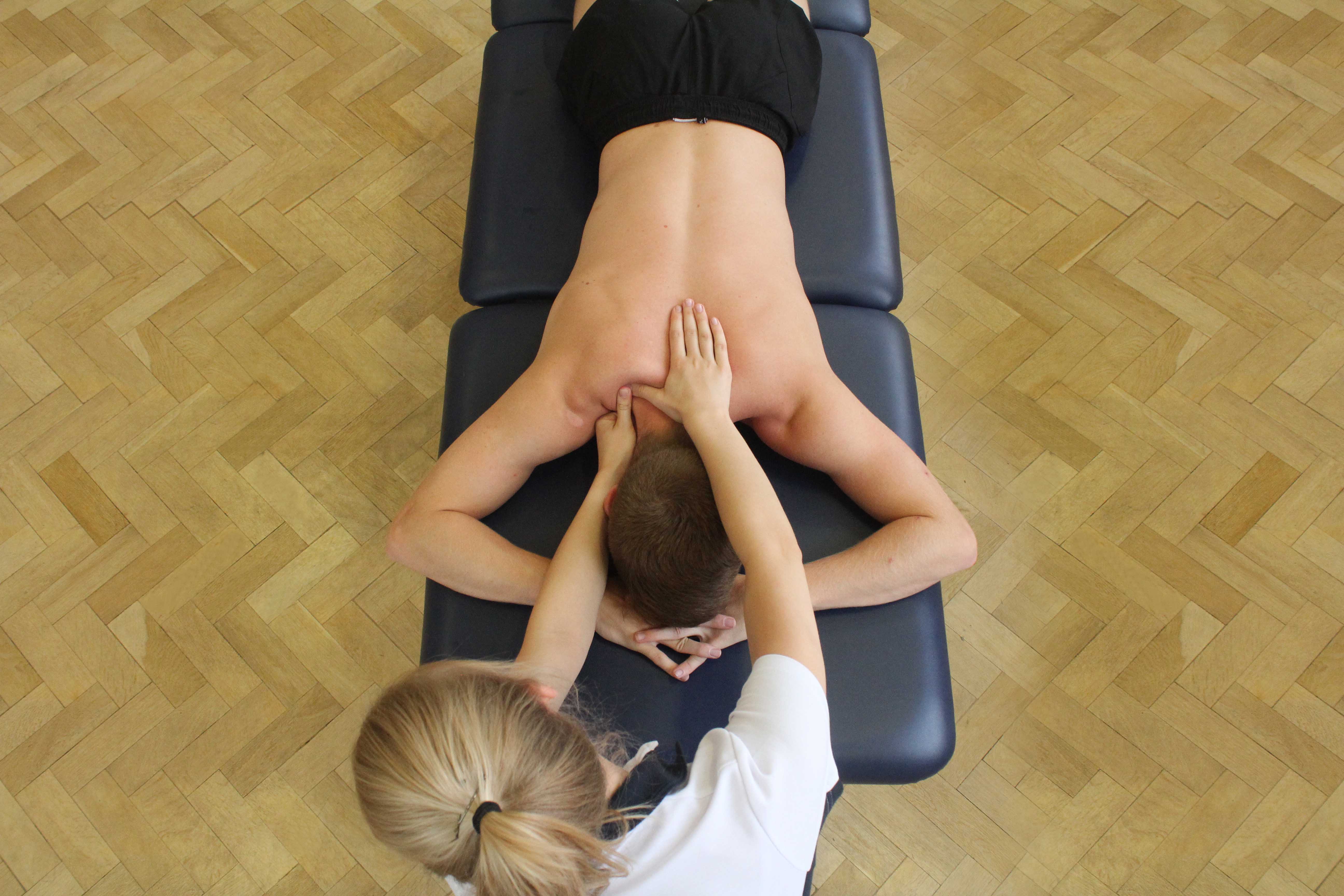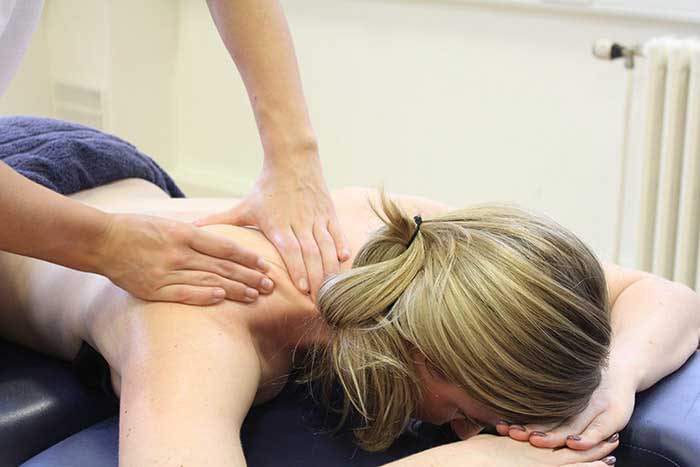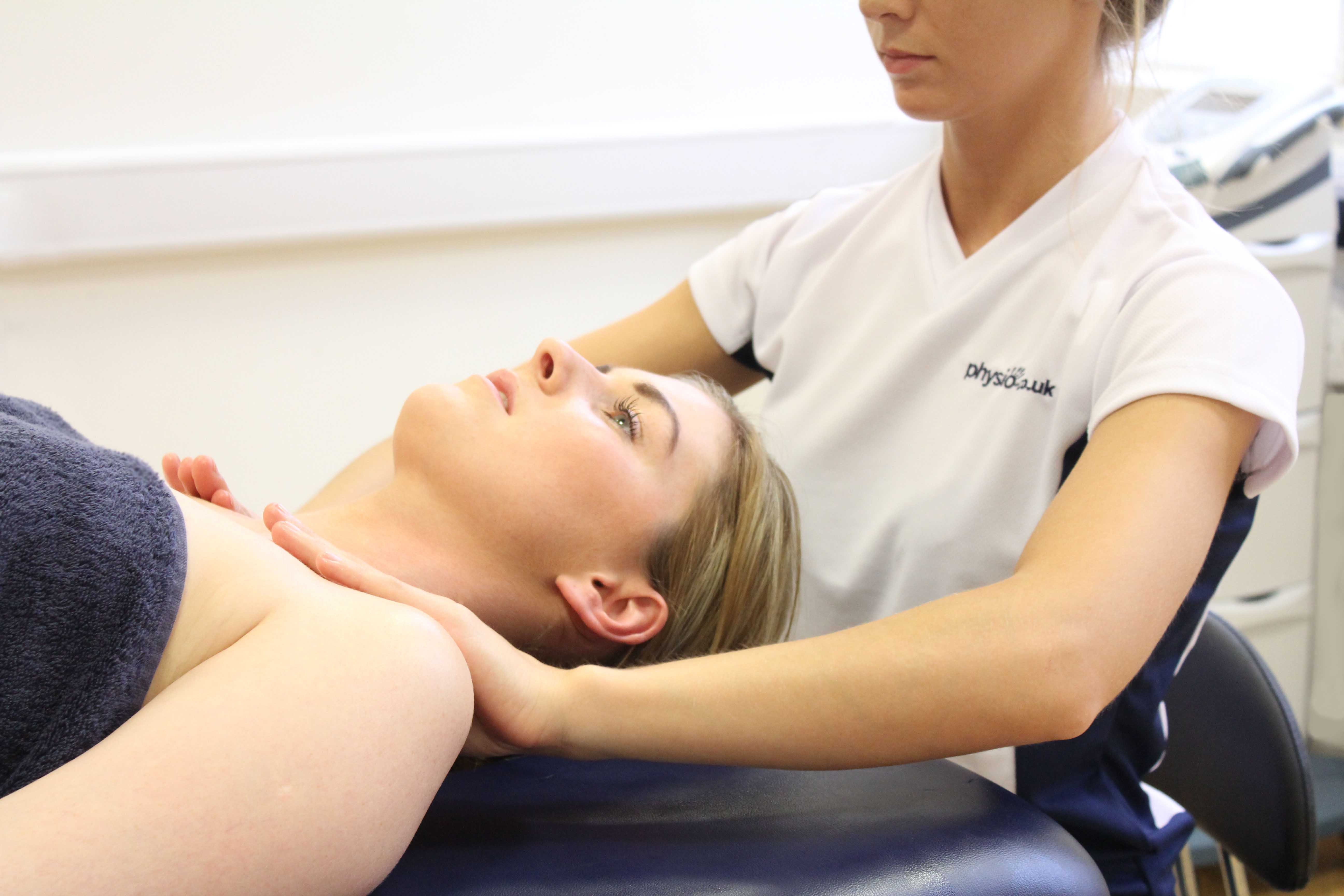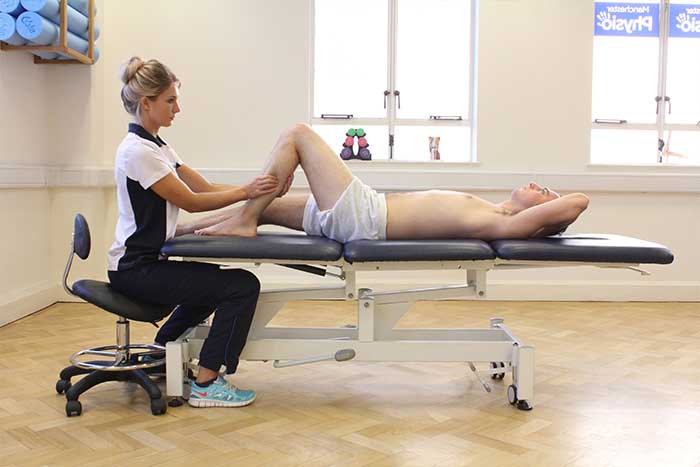Reduced stress is a benefit often gained through massage. Stress can be both physical and mental. Stress can physically occur within muscles after injury or overuse causing a buildup of tension resulting in an increase in pain. Stress can occur mentally due to restricted movement, pain or injury. Mental stress is caused by a hormone called cortisol which can also increase anxiety and depression. Where small amounts of stress can be good for a person, too much stress can cause pain, fear of returning to sport of injury and self-doubt. Our massage therapists at Physio.co.uk reduce stress through massage to help increase relaxation, reduce pain and improve a person's overall mood.
What are the most appropriate types of massage to reduce stress?
A range of massage types are appropriate to use to help reduce stress. The most common massage types used to reduce stress include:
 Above: Soft Tissue Massage targeting trapezius back muscles
Above: Soft Tissue Massage targeting trapezius back musclesThe massage techniques most commonly used to reduce stress include deep tissue massage, Swedish massage and therapeutic massage.
A deep tissue massage is used to reduce stress. A deep tissue massage focuses on the deeper layers within soft tissues. Stress can quite often be caused by a buildup of tension within muscles that restricts movement and increases pain. A deep tissue massage aims to relieve tension by stretching and spreading muscle fibres and tissues in order for muscles to relax and loosen. Loosened muscles increases movement, decreases pain and reduces stress.

Stress can be reduced through Swedish massage. The main aim of a Swedish massage is to relax a person both physically and mentally through the manipulation of muscles. Manipulation of the muscles encourages them to relax and stretch to relieve any tightness or tension, reducing physical stress. Tightness and tension causes" pain, increasing stress mentally levels. The relief of tightness and tension through Swedish massage also decreases mental stress.
A therapeutic massage is regularly used to reduce stress. A therapeutic massage uses a gentle pressure throughout on areas containing soft tissues. The main aim of a therapeutic massage is relaxation. When relaxation is poor, stress levels increase causing tension build-up, anxiety and muscular knots. A therapeutic massage increases localised blood flow. Within the blood flow are positive hormones endorphins, serotonin and dopamine. The positive hormones give a sense of well-being, increase relaxation and reduce stress. Increasing blood flow can also help to increase tissue elasticity by rising muscle temperature. Increased tissue elasticity reduces tension and prevent muscular knots from forming. Reduction in tension and prevention of muscular knots reduces stress.
What techniques are used to reduce stress?
Various techniques are used to reduce stress. The techniques most commonly used include:
 Above: Soft tissue massage of trapezius muscles
Above: Soft tissue massage of trapezius musclesThe most common techniques used to reduce stress include deep strokes, trigger pointing and lymphatic drainage.
Deep strokes are regularly used to reduce stress. Deep strokes involve using a firm pressure to get deep within muscle tissues. A lot of muscle stress can often come from deeper tissues as well as superficial. Stress located deeper within muscle tissues can cause increased pain and restricted movement. Deep strokes increase muscle temperature to increase tissue elasticity. Increasing tissue elasticity, loosens muscles and reduces stress and tension. Reduction of stress within muscles also decreases pain and increases movement.
Trigger pointing is an effective technique used to reduce stress. A trigger point is found in the centre of a muscle fibre. Trigger points are a buildup of stress and tension that form muscular knots. Trigger points can cause referred pain, headaches and can increase mental stress. Fingers and thumbs are used during trigger pointing to apply a firm pressure. As the pressure is applied an ischemic reaction occurs. An ischemic reaction is where blood flow I restricted to an area and then increases when pressure is released. Before the pressure is released, the pressure applied will start to soften, creating a numbing sensation. When the numbing sensation has occurred, more pressure can be applied depending on how deep or how big the trigger point is or the pressure can be released. Softening and numbing the trigger point reduces pain and headaches and relieves both mental and physical stress.
Stress can be reduced through lymphatic drainage. Lymphatic drainage involves the stimulation of the lymphatic system to remove metabolic wastes more efficiently. A buildup of metabolic wastes can occur after an injury, surgery or over use of a muscle. Metabolic wastes increase muscular fatigue and weakness and can result in swelling and pain. Swelling, muscular fatigue and muscular weakness can restrict movement and prevent injuries from healing. Restricting movement and preventing healing can increase mental stress as a person can become frustrated not being able to use the area of the body properly or returning to their exercise or sport. A massage stimulates the lymphatic system. A variety of long, deep strokes are used to flush out the metabolic wastes from the body and replace them with healthy oxygen and nutrients. Flushing metabolic wastes from the body more efficiently through lymphatic drainage reduces swelling, pain and restriction. Decreasing swelling pain and restriction reduces mental stress.

When can a massage help to reduce stress?
Reducing stress through massage can help in a variety of situations. The situations most commonly helped through reduced stress include:
The most common situations reduced stress through massage can help include acute pain, post injury and relaxation.
Pain can be decreased when stress is reduced. Both physical and mental stress can increase pain. Physical stress can restrict movement and create a build-up of tension. Mental stress occurs when there is already pain in the body. A stress hormone called cortisol is released in response to pain, further increasing pain. The more pain increases, the more stress increases which will in turn keep increasing the pain levels a massage aims to increase both muscle relaxation and mental relaxation. Muscles are encouraged to relax as an increase in temperature improves the muscle flexibility and range of movement. A massage will also try to flush the cortisol out of the body in order to reduce stress levels and decrease pain.
Reduced stress can help post injury. After an injury, conditions such as swelling, muscle fatigue and muscle weakness can arise. Stress can increase due to the inability to return to exercise and sport or due to the pain. A massage helps to encourage relaxation psychologically. Relaxation increases psychologically as the level of positive hormones increase. Positive hormones include endorphins, serotonin and dopamine. Increasing positive hormones can give person a sense of well-being as well as a positive frame of mind and "happy mood". Giving a sense of well-being and putting them in a positive frame of mind helps to reduce stress. Reducing stress increases healing time allowing a person to return to sport more quickly. Allowing a person to return to sport more quickly will reduce stress further.
Relaxation can be increased when stress is reduced. When stress levels are high both physically and mentally, relaxation is prevented. Muscle become tense meaning they stay in the state of contraction, and the pain created by tension can cause stress and frustration. A massage aims to relieve muscle tension. Friction is created between the skin and fingers during a massage, encouraging blood flow to increase. Increasing blood flow results in muscle temperature rising. Tissue elasticity increases when temperature rises, allowing muscle relaxation. Relaxation of muscles allows mental relaxation to also increase due to an increase in movement and decrease in pain.
What are the physiological effects of massage to reduce stress?
A variety of physiological effects occur during a massage to help reduce stress. The most common physiological effects that occur include:
The physiological effects that most commonly occur during a massage to help reduce stress include increased endorphins, serotonin and dopamine, decreased cortisol and increased tissue elasticity.
An increase in endorphins, serotonin and dopamine occurs during a massage to reduce stress. Endorphins, serotonin and dopamine are neurotransmitters released by stimulation of the autonomic system. Endorphins are responsible for relieving anxiety, serotonin prevents depression and gives a sense of well-being and dopamine increases motivation and prevents self-doubt. When the body lacks the positive hormones endorphins, serotonin and dopamine, a person can become stressed, anxious and can often have a feeling of loneliness. A massage stimulates the autonomic system, encouraging the release of the positive hormones. Increasing the level of positive hormones within the body, reduces stress and anxiety and can improve a person's overall mood.
Stress is reduced when a decrease in cortisol occurs. Cortisol is a negative hormone released from the adrenal gland when the hypothalamus had been stimulated. The adrenal gland is located on top of the kidneys and the hypothalamus is part of the brain. Cortisol is released into the blood flow and is transported around the body. Cortisol increases stress, anxiety and depression but is also responsible for the "fight or flight" response. When too much cortisol is released in response to factors such as pain, stress levels increase and the immune system becomes suppressed. A massage aims to flush out the cortisol from the blood flow and replace it with positive hormone endorphins, serotonin and dopamine. Replacing cortisol with positive hormones decreases stress and increases relaxation.
Summary
Reduced stress involves both physical and mental relaxation. A variety of massage types including deep tissue massage, Swedish massage and therapeutic massage are used to help reduce stress. Massage techniques such as deep strokes, trigger pointing and lymphatic drainage can be used to help reduce stress. There are a range of situations reduced stress through massage can help including acute pain, post injury and relaxation. Many physiological effects occur during a massage including increased endorphins, serotonin and dopamine and decreased cortisol all regularly occur throughout a massage to help reduce stress. Our massage therapists at Physio.co.uk reduce stress through massage to help relieve anxiety and encourage a person to return to sport or exercise.
How can I arrange a massage to reduce stress?
The easiest way to arrange a massage to reduce stress at Physio.co.uk is to email us at office@physio.co.uk or call us on 0800 033 7800.
You can also book an appointment online and save £10

 0330 088 7800
0330 088 7800






































